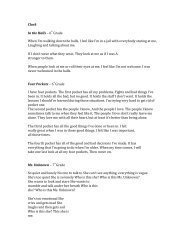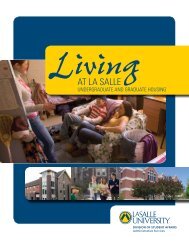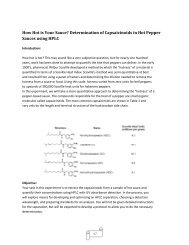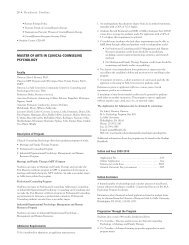To Suffer for Fashion - La Salle University
To Suffer for Fashion - La Salle University
To Suffer for Fashion - La Salle University
You also want an ePaper? Increase the reach of your titles
YUMPU automatically turns print PDFs into web optimized ePapers that Google loves.
to <strong>Suffer</strong><br />
<strong>for</strong> <strong>Fashion</strong> Writer<br />
Elizabeth Tabasko<br />
<strong>La</strong>yout Lindsay Beach<br />
Photographs Lindsay Beach & Abby McKweon<br />
The scene is not unfamiliar in today’s world. The first indication that they’re coming is<br />
the sound. In The Devil Wears Prada, the main character, Andy Sachs, calls the women the “clackers,” and they<br />
are everywhere. The clacking echoes throughout the subway station, becoming more frantic as a train pulls up.<br />
Their sound intensifies and the time between each sound quickens. It can be heard downtown just be<strong>for</strong>e 9 a.m.,<br />
amongst the taxi horns and screeching brakes on the SEPTA bus. In any academic building on campus, the sound<br />
fills the halls and stairwells.<br />
However, it doesn’t end when the books are shoved aside and the office lights turned off. On any given<br />
Saturday night, the clacking resumes, accompanying giggles and the clinking of glasses. They come in every<br />
imaginable color, from plain black to magenta, and in every size. Some of them are cheap, while others cost hundreds<br />
of dollars. They are a girl’s best friend, as they give her the body that nature robbed her of and allow her<br />
to stand eye-to-eye with her male counterparts. They are high heels, and they are slowly destroying the bodies<br />
of the young women who venture out in them every day.
I<br />
t’s not an easily ignorable<br />
trend. The glossy<br />
pages of every fashion<br />
magazine feature the<br />
shoes. Stilettos and pumps<br />
have <strong>for</strong>med a faithful following<br />
of females, appearing in every season complementing<br />
every new trend. When the weather turns<br />
cold, boots turn up with 3-inch heels allowing women<br />
to stay both warm and chic. However, women are not<br />
only influenced by fashion magazines. Carrie Brad-<br />
shaw, the main character of Sex in the City, made stilettos<br />
as important to the modern woman as a career.<br />
The shoes are more than an accessory. They are a sign<br />
of social status and style. But, while creating a perfect<br />
silhouette and completing an outfit, they are also destroying<br />
the body, literally from head to toe.<br />
Abby McKweon puts one hand against her dresser,<br />
supporting her body as she slides her foot into a pair<br />
of black leather pumps. She stands straight, looking in<br />
the mirror and examining her outfit thoroughly. “I’m<br />
about three inches taller now. It’s awesome. It makes<br />
all the difference,” she says, backing up slightly to gain<br />
one last look be<strong>for</strong>e walking out the door. McKweon is<br />
not unlike other girls on a Saturday night as she gets<br />
ready to go out with her friends. She will spend the<br />
night walking around Philadelphia, dancing with her<br />
friends, and running to catch the last subway home.<br />
But McKweon should know better. <strong>La</strong>st semester, she<br />
2<br />
“I was walking home, not really<br />
paying attention. I started to slip<br />
on the leaves, and my ankle<br />
twisted around. The heel of my<br />
shoe got stuck and I fell over.”<br />
spent six weeks in a full cast.<br />
The night began with selecting<br />
the perfect heels <strong>for</strong> a night<br />
out. However, this particular<br />
night ended in the emergency<br />
room. “I really didn’t think<br />
about it,” she explains. “They were new shoes and I was<br />
excited to wear them out with my friends.” McKweon<br />
recalls that it had rained the entire day, but cleared up<br />
that night. She describes the wet leaves which covered<br />
the sidewalk. “I was walking home, not really paying<br />
attention. I started to slip on the leaves, and my ankle<br />
twisted around. The heel of my shoe got stuck and I<br />
fell over,” she recalls. McKweon went to the emergency<br />
room, where doctors originally diagnosed a sprain.<br />
However, when the condition did not improve, McKweon<br />
returned and discovered her sprain was actually<br />
a fracture. “I spent six weeks in a boot. My friends<br />
started calling me ‘Boot.’ It was awful,” she says. Now,<br />
over a year later, she has not changed her habits. Her<br />
passion <strong>for</strong> high-heeled shoes has not subsided. She<br />
has chalked the experience up to an accident and refuses<br />
to change.<br />
Despite the pain of a sprained ankle and the humiliation<br />
of obtaining a new nickname, McKweon escaped<br />
relatively easily compared to the injuries of other<br />
women. Brandon Sams has worked as an X-ray technician<br />
at Einstein Medical Center <strong>for</strong> over three years.<br />
He has seen a myriad of different injuries, but recalls<br />
one dramatic instance of a pair of high heels causing<br />
severe damage to a young woman’s foot. The patient<br />
came into the emergency room limping after hurting<br />
her foot at a party while wearing high heels. After being<br />
assessed thoroughly, it was determined that an<br />
orthopedist would need to examine her further. She<br />
had a fracture near her first and second metatarsal<br />
regions, which include bones in the toes. “When you<br />
have your foot in a vulnerable and unnatural position<br />
wearing heels, you’re susceptible to injury with a misstep,”<br />
Sams explains. Surgery that involves placing pins<br />
near the bone would correct the injury. Months later,<br />
the foot healed and she was able to regain full use of<br />
it. While no permanent damage was done, the injury<br />
kept the patient from work and <strong>for</strong>ced her into months<br />
of painful recovery.<br />
These stories are not uncommon. These and many<br />
other injuries occur while wearing high heels. Accord-<br />
ing to a study from the International Journal of Humanities<br />
and Peace, tens of millions of Americans suffer<br />
from foot injuries every year, with women making up a<br />
great majority. Cited among these injuries are sprains,<br />
nerve irritations, and problems throughout other parts<br />
of the body, such as the neck and back. In the study,<br />
Jane Snyder, a physical therapist, describes the effects<br />
of wearing stilettos, explaining that “high heels cause<br />
the back and neck to hyperextend. The body compensates<br />
by flexing … the hips and spine.”<br />
Additionally, maintaining balance in these shoes<br />
causes the leg muscles to tense, which also eventually<br />
causes damage. While many women notice the blisters<br />
on their feet after a long day of commuting and look<br />
<strong>for</strong>ward to soaking sore feet when they return home,<br />
the long-term effects are often overlooked.<br />
Despite the bounty of clinical research pointing to<br />
high heels as the cause of many orthopedic problems<br />
3
and the horror stories of many young women, it is<br />
nearly impossible to convince the fashion-conscious to<br />
put away her designer shoes <strong>for</strong> something more reasonable.<br />
For centuries, women have used these shoes<br />
to accent their best outfits and create a more desirable<br />
image. With this in mind, many researchers are now<br />
doing studies to determine which shoes cause less<br />
damage to the feet. The <strong>La</strong>ncet examined the effects<br />
of wide-heeled and narrow-heeled shoes on the knees<br />
of young women. In the end, it was determined that<br />
wide-heeled shoes put a greater strain on the knees<br />
and increase the chance that the wearer<br />
will develop osteoarthritis at a younger<br />
age. In addition to measuring the width<br />
of the heel, researchers have noted that<br />
the height also plays a significant role in<br />
the risk of long-term effects. While passing<br />
up the latest trend in fashion may<br />
not be an option, many women may take<br />
solace in knowing that simply making different<br />
choices in styles may protect their<br />
feet and backs, while maintaining their<br />
reputation and dignity.<br />
Abby McKweon is not concerned about<br />
what she will feel like in the future or<br />
how the heels will ultimately affect her<br />
body. She is concerned about the near<br />
future, like this weekend, and not years<br />
ahead. However, a study in the Journal of Public Health<br />
Medicine focused on older women who, like many other<br />
young women today, did not yield to the warnings<br />
given to them years ago. In the study, researchers examined<br />
the age women started wearing high heels, the<br />
height of the shoes, and their occupational activities.<br />
All women had worn high heels throughout their lives<br />
and were currently dealing with health issues such as<br />
chronic foot pain and de<strong>for</strong>mities. The study included<br />
woman 50 to 70 years of age. Most of the women began<br />
wearing high heels at about 15 years old and 26<br />
percent had jobs which required them to wear high<br />
heels at work. While soaking tired feet in hot water<br />
seems to cure all foot ailments now, the study points<br />
4<br />
out what lies ahead <strong>for</strong> fashionable young women.<br />
<strong>To</strong>day’s blisters and bunions can easily become tomorrow’s<br />
sprains and fractures. What is now treated<br />
with bandages could soon need surgery and pins.<br />
While the threat of these injuries is very real, the tendency<br />
of young women to follow the hottest trends is<br />
unavoidable. Most shoes are created to make a statement<br />
and not necessarily <strong>for</strong> function. However, there<br />
are options <strong>for</strong> young women seeking to save their<br />
bodies years of pain while remaining faithful to the latest<br />
trends.<br />
Jane Snyder of the American Physical<br />
Therapy Association suggests limiting the<br />
amount of time wearing shoes, possibly<br />
keeping a spare to change into <strong>for</strong> times<br />
when more stress will be placed on the<br />
feet. While her advice is practical, other<br />
women are taking a more proactive approach.<br />
In The Globe and Mail, Anyi Lu, a<br />
chemical engineer turned shoe designer,<br />
describes her mission: “Manolo Blahnik<br />
has said that he designs shoes <strong>for</strong> women<br />
who sit. I design shoes <strong>for</strong> women who<br />
are on the go, with style,” she says. It may<br />
provide young women with hope that<br />
fashion and function will soon merge al-<br />
Abby enjoys a night in heels with lowing <strong>for</strong> the maintenance of a young<br />
her friend Chino Hernandez.<br />
healthy body and ego.<br />
There is little chance that the clacking will cease anytime<br />
soon. As long as fashion designers, magazines,<br />
and celebrities endorse that style, women will buy<br />
into the trend. There is limited awareness about the<br />
problem and little done to remedy it. However, with<br />
shoe designers like Anyi Lu on the rise, perhaps hope<br />
is in sight. If stilettos and com<strong>for</strong>t find a way to unite,<br />
there is no question that women would immediately<br />
trade in their own heels <strong>for</strong> new ones with a better<br />
design.<br />
“Sure, I’d love a shoe like that,” McKweon says, sitting<br />
on her bed, continuing to prepare <strong>for</strong> her night out.<br />
“But until then…,” she laughs and waves a red shoe in<br />
the air, holding it by its long, thin heel. =<br />
Back to <strong>La</strong> Salon
















